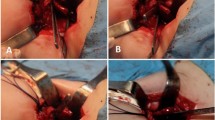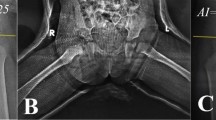Abstract
Background: Treatment for developmental dysplasia of the hip (DDH) varies according to the age of the patient. For children under 3 months, the preferred treatment is Pavlik bandaging and/or dynamic hip orthosis;for children of 3–18 months (with/without arthrography), closed and open reductions (ORs) are most common; and for children 18 months and older, pelvic osteotomies are used. Radiological and functional outcomes of patients between 16 months and 7 years of age who underwent Pemberton pericapsular osteotomy (PPO) were evaluated.
Materials and Methods: Twelve patients with developmental dysplasia of the hip (DDH) received treatment on 14 hips between 2001 and 2006. All patients with DDH had PPO as pelvic osteotomy. PPO was done solely in 3 hips, PPO and open reduction (OR) in and OR + PPO + femoral shortening in 6. The average age was 39.85 months (range 16–83 months). All had 1-stage surgery. Acetabular index (AI) and the grade of displacement were determined according to Tönnis’. Center-edge (CE) angle was evaluated. Clinical evaluations were made as described by McKay, radiological assessments by Severin’s criteria and femoral head avascular necrosis measurements by Kalamchi-MacEwen’s criteria. Average followup periods were 83.35 months (range 48–115 months).
Results: Preoperative and postoperative average Al levels were 41.92° (range 30–50°) and 19,5° (range 5–34°), respectively (P < 0.001). According to Severin’s classification, 11 (78.57%) patients were Ia, 1 (7.14%) was lb, 1 (7.14%) was II and 1 (7.14%) was III. According to Kalamchi-McEven criteria, 12 (85.71%) patients were type I, 2 (14.28%) patients were type II. CE postoperatively was measured as 24.24° (range 12–41°). Clinically (McKay), the functional results in 13 (92.85%) patients were very good (I) and in 1 (7.14%) was good (II).
Conclusions: Functional and radiological mid term outcomes were found to be comparable in most of the patients with DDH undergoing PPO between the ages of 16 months and 7 years.
Similar content being viewed by others
References
Akel I, Tumer Y. Residual acetabular dysplasia-natural history and indication for surgery. Turkiye Klinikleri J Orthop Traumatol Spec Top 2010;3:10–3.
Bursali A, Tonbul M. How are outcomes affected by combining the Pemberton and Salter osteotomies? Clin Orthop Relat Res 2008;466:837–46.
Pemberton PA. Pericapsular osteotomy of the ilium for treatment of congenital subluxation and dislocation of the hip. J Bone Joint Surg Am 1965;47:65–86.
Salter RB, Dubos JP. The first fifteen year’s personal experience with innominate osteotomy in the treatment of congenital dislocation and subluxation of the hip. Clin Orthop Relat Res 1974;98:72–103.
Tönnis D. An evaluation of conservative and operative methods in the treatment of congenital hip dislocation. Clin Orthop Relat Res 1976;119:76–88.
Tukenmez M, Perc S, Tezeren G, Cingoz MA. The outcomes of salter innominate osteotomy in the treatment of developmental dysplasia of the hip. Turkiye Klinikleri J Med Sci 2006;26:390–5.
Utterback JD, MacEwen GD. Comparison of pelvic osteotomies for the surgical correction of the congenital hip. Clin Orthop Relat Res 1974;98:104–10.
Bhuyan BK. Outcome of one-stage treatment of developmental dysplasia of hip in older children. Indian J Orthop 2012;46:548–55.
El-Sayed M, Ahmed T, Fathy S, Zyton H. The effect of Dega acetabuloplasty and Salter innominate osteotomy on acetabular remodeling monitored by the acetabular index in walking DDH patients between 2 and 6 years of age: Short- to middle-term followup. J Child Orthop 2012;6:471–7.
Sankar WN, Tang EY, Moseley CF. Predictors of the need for femoral shortening osteotomy during open treatment of developmental dislocation of the hip. J Pediatr Orthop 2009;29:868–71.
Vitale MG, Skaggs DL. Developmental dysplasia of the hip from six months to four years of age. J Am Acad Orthop Surg 2001;9:401–11.
Galpin RD, Roach JW, Wenger DR, Herring JA, Birch JG. One-stage treatment of congenital dislocation of the hip in older children, including femoral shortening. J Bone Joint Surg Am 1989;71:734–41.
Wenger DR, Lee CS, Kolman B. Derotational femoral shortening for developmental dislocation of the hip: Special indications and results in the child younger than 2 years. J Pediatr Orthop 1995;15:768–79.
Schoenecker PL, Strecker WB. Congenital dislocation of the hip in children. Comparison of the effects of femoral shortening and of skeletal traction in treatment. J Bone Joint Surg Am 1984;66:21–7.
Klisic P, Jankovic L. Combined procedure of open reduction and shortening of the femur in treatment of congenital dislocation of the hips in older children. Clin Orthop Relat Res 1976;119:60–9.
Berkeley ME, Dickson JH, Cain TE, Donovan MM. Surgical therapy for congenital dislocation of the hip in patients who are twelve to thirty-six months old. J Bone Joint Surg Am 1984;66:412–20.
Severin E. Congenital dislocation of the hip; development of the joint after closed reduction. J Bone Joint Surg Am 1950;32-A: 507–18.
Kalamchi A, MacEwen GD. Avascular necrosis following treatment of congenital dislocation of the hip. J Bone Joint Surg Am 1980;62:876–88.
Classic. Translation: Hilgenreiner on congenital hip dislocation. J Pediatr Orthop 1986;6:202–14.
Razali NM, Wah YB. Power comparisons of Shapiro-Wilk, Kolmogorov-Simirnov, Lilliefors and Anderson-Darling tests. J Stat Model Analytics 2011;2:21–33.
Bulut M, Gürger M, Belhan O, Batur OC, Celik S, Karakurt L. Management of developmental dysplasia of the hip in less than 24 months old children. Indian J Orthop 2013;47:578–84.
Omeroglu H, Biçimoglu A, Agus H, Tümer Y. Measurement of center-edge angle in developmental dysplasia of the hip: A comparison of two methods in patients under 20 years of age. Skeletal Radiol 2002;31:25–9.
Coleman SS. The incomplete pericapsular (Pemberton) and innominate (Salter) osteotomies; a complete analysis. Clin Orthop Relat Res 1974;98:116–23.
Herring JA, editor. Developmental dysæplasia of the hip. In: Tachdjian’s Pediatric Orthopedics. 3rd ed., Vol. 1. Philadelphia: W.B. Saunders; 2002. p. 513–654.
Solomczykowski M, Mackenzie WG, Stern G, Keeler KA, Glutting J. Acetabular volume. J Pediatr Orthop 1998;18:657–61.
Author information
Authors and Affiliations
Corresponding author
Rights and permissions
About this article
Cite this article
Balioğlu, M.B., Öner, A., Aykut, Ü.S. et al. Mid term results of Pemberton pericapsular osteotomy. IJOO 49, 418–424 (2015). https://doi.org/10.4103/0019-5413.159627
Published:
Issue Date:
DOI: https://doi.org/10.4103/0019-5413.159627




